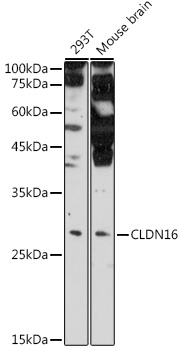CLDN16 Polyclonal Antibody
For reference only. Please follow the manual included in your kit for instructions.
Catalog Number
RD90027A
Product Name
CLDN16 Polyclonal Antibody
Catalog Number
RD90027A
Clonality
Polyclonal
Purification Method
Affinity purification
Isotype
IgG
Host
Rabbit
Background
Tight junctions represent one mode of cell-to-cell adhesion in epithelial or endothelial cell sheets, forming continuous seals around cells and serving as a physical barrier to prevent solutes and water from passing freely through the paracellular space. These junctions are comprised of sets of continuous networking strands in the outwardly facing cytoplasmic leaflet, with complementary grooves in the inwardly facing extracytoplasmic leaflet. The protein encoded by this gene, a member of the claudin family, is an integral membrane protein and a component of tight junction strands. It is found primarily in the kidneys, specifically in the thick ascending limb of Henle, where it acts as either an intercellular pore or ion concentration sensor to regulate the paracellular resorption of magnesium ions. Defects in this gene are a cause of primary hypomagnesemia, which is characterized by massive renal magnesium wasting with hypomagnesemia and hypercalciuria, resulting in nephrocalcinosis and renal failure. This gene and the CLDN1 gene are clustered on chromosome 3q28.
Immunogen Information
Immunogen
A synthetic peptide of human CLDN16
Gene ID
10686
Swissprot
Q9Y5I7
Synonyms
CLDN16HOMG3PCLN1
Calculated MW
12kDa
Observed MW
16kDa
Applications
Reactivity
Human,Mouse
Tested Applications
WB
Conjugation
Unconjugated
Dilution
WB 1:500-1:2000
Concentration
1mg/mL
Storage Buffer
PBS with 0.02% sodium azide,50% glycerol,pH7.3.
Storage Instructions
Store at -20°C Valid for 12 months. Avoid freeze / thaw cycles.
